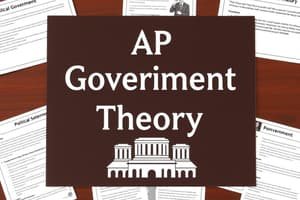Podcast
Questions and Answers
What is government?
What is government?
- An organization that provides public services.
- An institution that makes and enforces public policy. (correct)
- A social structure with no enforcement capabilities.
- A type of financial institution.
What is political efficacy?
What is political efficacy?
The belief that citizens have the ability to make a positive change in society.
What characterizes a representative democracy?
What characterizes a representative democracy?
A system in which citizens elect representatives to decide policies on their behalf.
What are linkage institutions?
What are linkage institutions?
The power is concentrated in a narrow 'ruling class' of wealthy and well-connected individuals is called ______.
The power is concentrated in a narrow 'ruling class' of wealthy and well-connected individuals is called ______.
What does the pluralist theory assert?
What does the pluralist theory assert?
What is hyperpluralist theory?
What is hyperpluralist theory?
The process of making laws and policies by various governmental branches is called the ______.
The process of making laws and policies by various governmental branches is called the ______.
What is a key belief of liberals in political ideology?
What is a key belief of liberals in political ideology?
Which statement describes conservatives?
Which statement describes conservatives?
What do the Civil War amendments include?
What do the Civil War amendments include?
Judicial restraint means that judges should actively shape public policy.
Judicial restraint means that judges should actively shape public policy.
What is the amendment process?
What is the amendment process?
What is the purpose of block grants?
What is the purpose of block grants?
What does the 2nd Amendment protect?
What does the 2nd Amendment protect?
What is the significance of Miranda v. Arizona?
What is the significance of Miranda v. Arizona?
What is the electoral college?
What is the electoral college?
What factors influence who votes?
What factors influence who votes?
What is the function of standing committees?
What is the function of standing committees?
What do interest groups do?
What do interest groups do?
Flashcards are hidden until you start studying
Study Notes
Government and Political Systems
- Government is the institution responsible for creating and enforcing public policy (laws).
- Political efficacy refers to citizens' belief in their ability to enact positive societal change, fostering civic engagement.
- Representative democracy allows citizens to elect representatives who decide policies on their behalf.
- Linkage institutions, like media, interest groups, and political parties, connect citizens to the government and shape the policy agenda.
Political Theories
- Elitist theory posits that power is held by a small, wealthy ruling class primarily focused on their interests.
- Pluralist theory suggests that power is distributed among various groups, with policies resulting from competition and compromise.
- Hyperpluralist theory warns that strong interest groups can weaken government efficiency, causing gridlock.
Impact of Technology and Ideological Spectrum
- Technology has transformed communication and engagement in politics, leading to changes in public opinion and activism.
- Liberals advocate for government intervention to address perceived injustices and support more regulations on economic issues.
- Conservatives emphasize traditional policies aimed at preserving the status quo with minimal government involvement.
- Moderates represent the majority of Americans, often holding balanced views.
Judicial Philosophies and Constitutional Amendments
- Judicial activism involves judges using their interpretations to achieve societal goals, while judicial restraint emphasizes congressional authority to make policies.
- Originalism advocates interpreting the Constitution based on the framers' intent.
- Civil War Amendments include the abolition of slavery (13th), defining citizenship and equal protection (14th), and voting rights irrespective of race (15th).
Legislative Branch Characteristics
- The House of Representatives has 435 members serving two-year terms, initiating revenue bills and impeachment.
- The Senate comprises 100 members serving six-year terms, focusing on foreign policy and confirming presidential nominees.
Federalism and Powers
- Federalism divides power between national and state governments, with the Constitution being the supreme law.
- The amendment process requires a two-thirds majority in Congress and ratification by three-fourths of the states.
Rights and Legal Precedents
- The Bill of Rights protects individual liberties and was initially limited to the national government.
- Key Supreme Court cases include:
- Miranda v. Arizona: Ensures rights of the accused during police interrogations.
- Marbury v. Madison: Establishes the principle of judicial review.
- McCulloch v. Maryland: Validates implied powers of Congress and national supremacy over state laws.
- Roe v. Wade: Recognizes a constitutional right to privacy regarding abortion.
Public Opinion and Voting Behavior
- Public opinion reflects citizens' attitudes on issues, with polls serving as snapshots of this sentiment.
- Voting is influenced by education, gender, race, income, and age, with certain demographics exhibiting higher participation rates.
Political Processes and Structures
- Standing committees handle specific policy areas, while conference committees reconcile differences between House and Senate bills.
- Interest groups play critical roles in educating the public, mobilizing activism, and influencing policy through direct engagement with lawmakers.
Elections and Voting Systems
- Plurality elections award victory to the candidate with the most votes, while electoral college mechanics determine presidential elections.
- Open primaries allow any voter to participate, while closed primaries restrict voting to registered party members.
Economic Policies and Bureaucracy
- Fiscal policy refers to government tax and spending decisions, with monetarists focusing on the money supply.
- The Federal Reserve manages interest rates and money supply through bond transactions.
- Budget deficits arise when government expenditures surpass revenues, indicating financial shortfalls.
Additional Concepts
- Incumbents in Congress benefit from name recognition, media access, and fundraising advantages, often leading to re-election.
- Divided government occurs when different parties control the presidency and Congress, affecting legislative productivity.
- Bureaucracy operates through a structured hierarchy, ensuring task specialization and adherence to standard operating procedures.
Studying That Suits You
Use AI to generate personalized quizzes and flashcards to suit your learning preferences.




